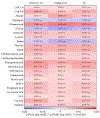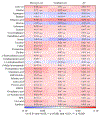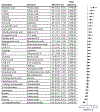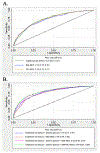Plasma metabolomic signatures of obesity and risk of type 2 diabetes
- PMID: 36161775
- PMCID: PMC9633360
- DOI: 10.1002/oby.23549
Plasma metabolomic signatures of obesity and risk of type 2 diabetes
Abstract
Objective: The mechanisms linking obesity to type 2 diabetes (T2D) are not fully understood. This study aimed to identify obesity-related metabolomic signatures (MESs) and evaluated their relationships with incident T2D.
Methods: In a nested case-control study of 2076 Chinese adults, 140 plasma metabolites were measured at baseline, linear regression was applied with the least absolute shrinkage and selection operator to identify MESs for BMI and waist circumference (WC), and conditional logistic regression was applied to examine their associations with T2D risk.
Results: A total of 32 metabolites associated with BMI or WC were identified and validated, among which 14 showed positive associations and 3 showed inverse associations with T2D; 8 and 18 metabolites were selected to build MESs for BMI and WC, respectively. Both MESs showed strong linear associations with T2D: odds ratio (95% CI) comparing extreme quartiles was 4.26 (2.00-9.06) for BMI MES and 9.60 (4.22-21.88) for WC MES (both p-trend < 0.001). The MES-T2D associations were particularly evident among individuals with normal WC: odds ratio (95% CI) reached 6.41 (4.11-9.98) for BMI MES and 10.38 (6.36-16.94) for WC MES. Adding MESs to traditional risk factors and plasma glucose improved C statistics from 0.79 to 0.83 (p < 0.001).
Conclusions: Multiple obesity-related metabolites and MESs strongly associated with T2D in Chinese adults were identified.
© 2022 The Obesity Society.
Conflict of interest statement
Disclosure
No potential conflicts of interest relevant to this article were reported.
Figures





References
-
- International Diabetes Federation. IDF Diabetes Atlas 10th Edition 2021. [cited 2022 May 25]. Available from: https://www.diabetesatlas.org/en/.
-
- Rosenthal AD, Jin F, Shu XO, Yang G, Elasy TA, Chow WH, et al. Body fat distribution and risk of diabetes among Chinese women. Int J Obes Relat Metab Disord 2004;28: 594–599. - PubMed
-
- Pan XF, Wang L, Pan A. Epidemiology and determinants of obesity in China. Lancet Diabetes Endocrinol 2021;9: 373–392. - PubMed
Publication types
MeSH terms
Grants and funding
LinkOut - more resources
Full Text Sources
Medical
Miscellaneous

